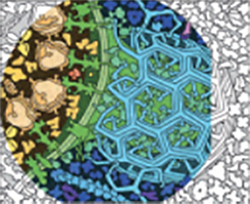Outreach and Education 
New Video: How Neurons Communicate
The billions of neurons in our nervous system are constantly communicating. The signals they send to each other are responsible for our thoughts, sensations, and actions. Learn how ions, ion channels, receptors, and neurotransmitters work together to enable the neuronal signaling process.
Visit PDB-101 to watch An Introduction to Neurotransmission and Action Potential.
New Coloring Page
The Biologist magazine hosts the Big Biochemical Colouring-in Series to invite readers to get artistic while learning about some of the life sciences’ most important and interesting macromolecules.
The latest feature on Clathrin-coated pit has been published and made available at PDB-101.
The Biologist is published four times a year by the Royal Society of Biology. Many thanks to the Royal Society of Biology for sharing these pages with PDB-101.
PDB-101 hosts a collection of molecular-themed coloring books.
Exploring the Structural Biology of Cancer
Structural biologists are studying all aspects of this process, including the mechanisms that underpin damage to and repair of the genome, the way that these genetic changes lead to cancer, and ways for us to use this knowledge to discover and develop new treatments to fight cancer.

Guide to Understanding PDB Data: Hierarchical Structure
The constantly-growing PDB is a reflection of the research that is happening in laboratories across the world. This can make it both exciting and challenging to use the database in research and education.
PDB-101's Guide to Understanding PDB Data was created to help users navigate through the contents of the archive without having a detailed background in structural biology. Topics cover biological assemblies, molecular graphics programs, R-value and R-free, and more.
A new chapter highlights the Hierarchical Structure of Proteins, including:
- Why is Understanding Protein Folding Important?
- Hierarchical Structure
- Visualization of Hierarchical Structure
- Classifying Protein Folds
Meeting Report: ABRCMS
Two students who spent the summer of 2022 with RCSB PDB presented their work at the Annual Biomedical Research Conference for Minoritized Scientists (ABRCMS) this past November.
Undergraduates Emma Chavez (Hendrix College) and Jordi Urquizo (Rutgers University-Newark) joined the team as part of the Research Intensive Summer Experience (RISE) at Rutgers program. They worked alongside the RCSB PDB and members of the Rutgers Institute for Quantitative Biomedicine to study the impact of potential mutations of the SARS-CoV-2 main protease and drug binding. Their research led to travel awards to attend and present at the meeting.
Undergraduates interested in working with the RCSB PDB and/or the Rutgers University community are encouraged to apply as soon as possible to the RISE program. Applications are open now and will close when positions are filled (typically by early February). Questions should be sent to Christine.Zardecki@rcsb.org.

Emma Chavez (left) and Jordi Urquizo presenting their posters.

